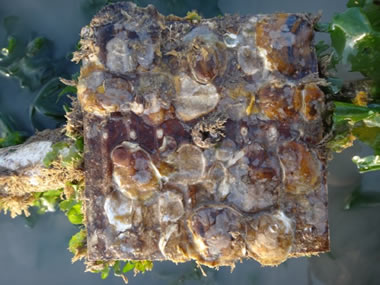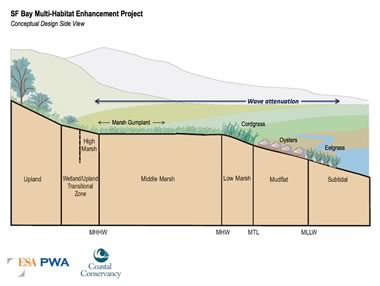Project: Integrated Restoration in San Francisco Bay
The State Coastal Conservancy, US Fish and Wildlife Service, and many regional partners are working on a new project – “Integrated Restoration in San Francisco Bay: Maximizing Ecological Function and Shoreline Protection through a Multi-habitat Living Shoreline Approach”. This innovative climate adaptation and habitat restoration project will apply the synthesized findings of two successfully established Conservancy programs: the SF Bay Living Shorelines Project, and active tidal marsh revegetation via the SF Estuary Invasive Spartina Project. The overarching goal is to actively enhance four native foundation species: Pacific cordgrass (Spartina foliosa), marsh gumplant (Grindelia stricta), native oysters (Ostrea lurida), and native eelgrass (Zostera marina)into one integrated living shoreline approach that enhances habitat and further tests nature-based approaches to shoreline protection.
This proposed project has been developed based upon successful past work in each habitat to date, and on the recommendations of the 2010 San Francisco Bay Subtidal Habitat Goals Report and 2015 Science Update to the Baylands Ecosystem Goals Report. These regional reports recommend that climate adaptation projects integrate nature-based habitat designs; and include multiple habitat types to improve linkages among habitats and promote synergistic effects of habitat features on each other as well as on associated fauna.
The project’s integrated approach involves restoring these habitats as a linked gradient from marsh to intertidal reefs and subtidal aquatic beds, thereby increasing habitat connectivity and structure while promoting two restoration goals: to increase habitat and physical attributes such as wave attenuation. The Conservancy and partners at San Francisco State Romberg-Tiburon Center, UC Davis, and Olofson Environmental, Inc are partnering with landowners at seven sites Baywide in 2015-16 to install small test plots to assess survival of each species. These seven sites include Giant Marsh near Pt Pinole, San Rafael Shoreline, Elsie Roemer Marsh, Eden Landing Ecological Reserve, Ravenswood Salt Ponds/Slough, Coyote Point, and Oyster Point. Small coconut fiber logs and Pacific oyster shell bags are being tested as mini wave breaks to protect new cordgrass plantings in higher wave energy sites.
The Giant Marsh location will be the focus of a large-scale restoration project to be constructed in summer 2017. This work is led by the Conservancy in partnership with landowner East Bay Regional Parks, and funded by two recent grants from US Fish and Wildlife Service- a North American Waterfowl Conservation Act grant, and a National Coastal Wetlands Conservation Grant. The SF Bay Joint Venture has been a supportive partner and the Conservancy is looking forward to sharing updates and progress on this exciting new effort. For more information, please contact Project Manager Marilyn Latta at 510-286-4157 or marilyn.latta@scc.ca.gov.




